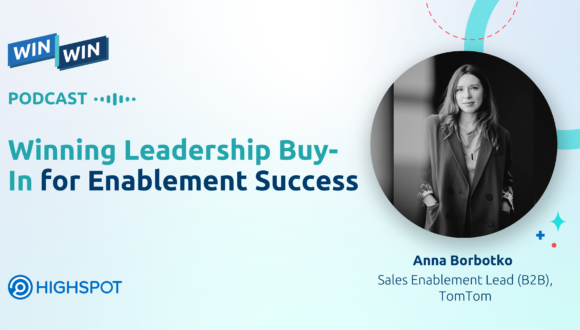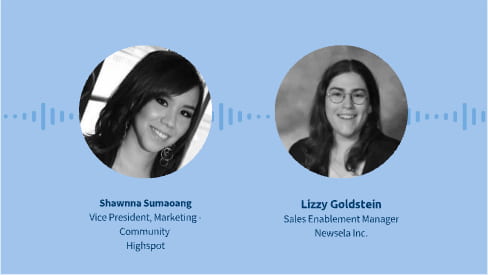According to a study by Gartner, 83% of heads of sales report sellers struggle to adapt to changing customer needs. So how can you build an enablement strategy that ensures you’re meeting every seller where they are?
Shawnna Sumaoang: Welcome to the Win Win Podcast. I am your host, Shawnna Sumaoang. Join us as we dive into changing trends in the workplace and how to navigate them successfully.
Here to discuss this topic is Shelby Luchini, the strategic content go-to-market enablement manager for Grammarly. Thank you for joining us, Shelby. I would love for you to tell us about yourself, your background, and your role.
Shelbi Luchini: Awesome, thanks for having me. A little bit about me, I’ve been at Grammarly for a little over a year in our enablement org, and prior to that, I was at Outreach for about seven years. I had an awesome journey there where I started as a customer-facing rep and moved into enablement and I really love onboarding, coaching, and training reps. At Grammarly, I’ve been doing that same thing.
We have an awesome enablement team here and my role is working on strategic programs that scale across our market org. So from BDRs, all the way to RCS and SC function. Anytime we’re building out programs that might have to do with discovery or new feature releases, new content for our teams, and working really closely with our product marketing partners, that’s where you’ll find me.
SS: Wonderful, we are excited to have you here. As an experienced enablement leader, I’d love to start with understanding some of your key considerations for crafting an enablement strategy that really drives impact.
SL: First and foremost is really making sure that we have a buy-in and a good understanding, from the leaders as to what they’re looking for as far as accomplishing goals. Standing up some strong KPIs around what we’re looking to accomplish with the program and working really closely with reps.
So we have some segment enablement managers on the enablement org that I work really closely with. We partner closely with the AEs, CSMs, any roles that we’re rolling out to, to make sure that we’re getting not only the leadership and the manager perspective but rep perspective on what they’re struggling with and what the problems that we’re looking to solve with any of the enablement programs.
That’s first and foremost, and then having a really strong reinforcement strategy. So one thing I’ve learned with enablement that’s super important is, trying to avoid flash-in-the-pan enablement where you might have a bunch of ad hoc requests coming through from leaders or reps and making sure that you have a strong reinforcement strategy to bolster on top of the enablement programs that you roll out.
SS: You talk a lot about your experience building enablement programs from scratch, particularly on LinkedIn, which I love. What are some of your best practices for building enablement programs from the ground up to support your go-to-market initiatives?
SL: It comes back to having that manager buy-in and having managers support enablement programs when you don’t have some of that reinforcement from the leaders. It’s really difficult to make sure that reps are taking trainings, or even invested in their learning and development. It comes with the culture and laying the culture and the foundation is probably where, if you don’t have that, it’s going to be really hard to stand up an enablement program from the get-go.
So there’s that. I also think that building strong foundational partnerships with go-to-market teams, like product marketing, those different departments are super fundamental to the success of any enablement program. So I think manager reinforcement and the partnerships that enablement builds are really crucial to any success of building something from the ground up.
And then lastly, I’ll say having a strong vision for what enablement looks like is awesome, but also having some quick wins. Putting together a strong roadmap is great in partnership with leaders and everything when you get in, and maybe a sales team isn’t super used to getting help from any sort of enablement or having resources.
Having quick wins to show, hey, this team is really valuable to our organization and they’re just trying to help us learn and grow both professionally and personally. I think that’s super key to having a strong enablement program and starting from the ground up.
SS: Yes, I could not agree more. It’s fantastic that you’re striking that balance between the long-term strategy and also supporting those quick wins. How does your enablement platform help you to deliver on both of those components, both your strategy and the quick wins to support your go-to-market initiatives?
SL: We use Highspot as one of our enablement platforms, and it really allows us to direct the teams to a one-stop shop. So they always know that Highspot is the platform to go to after we have any sort of all-hands meeting or an enablement meeting or training, and it supports us in getting out new content. Our marketing and product marketing team does an awesome job of developing really great thought leadership and content.
And we’re always. It’s, putting that in front of our teams, to support some of those ad hoc requests that might come through as well as, big strategy enablement programs like Discovery Playbooks or Persona Playbooks. And we’re always driving reps to Highspot and they never have to guess where content or enablement programs or trainings live. It’s always in that one place.
SS: I love that. And I know one of Grammarly’s key initiatives this year is ensuring that you’re constantly upleveling both your new and experienced reps for discovery, especially with the c-suite persona. How are you driving this effort through your enablement programs?
SL: We’re trying to weave discovery and that starts from the most basic foundational discovery playbooks. Giving reps insight into how to use insight openers and data to have compelling questions and dig in and uncover payoff and impact with their customers.
But we’ve rolled out a ton of different Plays, and that includes Plays from discovery, buyer personas, as well as any new feature releases that we’re rolling out. We’re always trying to incorporate Discovery questions into that, and how can they make sure that this is just a natural part of everything?
Any sort of enablement program that we roll out to just have it be muscle memory, right? We want it to be second nature as far as when they’re having those conversations with prospects and customers really leaning in and they should be sprinkling discovery into every conversation that they have.
Discovery isn’t just a one moment in time or one call. It’s all always happening throughout the entire sales cycle. We want to make sure that muscle memory is really baked in and really an inherent skill for reps.
SS: And you have a particular interest in utilizing Digital Rooms. How are your teams leveraging Digital Rooms to really personalize the buyer experience for some of your key personas?
SL: Digital Rooms has been a really exciting thing for our teams. Just to give a little context, prior to using Highspot and Digital Rooms, our reps were sending out emails with big file attachments, it was probably getting lost in a lot of prospects inboxes, and very difficult to find information and send it out to prospects with the latest and greatest.
So Digital Rooms, what I love about it is it’s allowed our reps to be themselves, it shows their personality. They’ve added pictures of themselves showing their hobbies and putting a face to the name, almost similar to like a LinkedIn, but next level, which I love.
And then we also have content that’s definitely personalized to our different buyer personas. And so giving guidance on hey, here’s some information that you might send to a marketing persona or a CX buyer. So we’re really clear with our descriptions and our content of what what content might be applicable to different personas that they’re reaching out to.
So it should be really easy for the reps to drag and drop content into our different Digital Room templates that we’ve created. So we have a handful of different Digital Room templates that reps can just go ahead and create, and then they’re also just making copies. They’re sharing out Digital Rooms with one another.
So it’s been a really great experience and I think reps are using it across the deal cycle. Not even just to help them close deals, but after the fact, passing some of the Digital Rooms over to some of our onboarding folks, so they can continue the journey with our customers.
SS: I love that. And I’d love to dig into that maybe in another podcast, cause I’m always curious about how companies are using it across the entire journey, not just pre-sales, but post-sales as well, so that’s exciting to hear. Now, you’ve also seen some really great results utilizing Sales Plays with your teams and you guys have.
92% adoption, which is amazing. What are some of your best practices for building effective sales plays that really help your teams land these go to market initiatives in the field?
SL: I think one of the biggest things for our teams is just consistency; consistency and how Plays look, how they feel and the rate at which we roll out different Sales Plays, right? I think it comes back to the flash-in-the-pan enablement and trying to avoid doing some of that. But anytime we’re doing, you know a tier two or a tier three feature launch for example, there’s always an associated Play and it always includes insight into those discovery questions—what are some discovery questions you can incorporate to dig deeper, uncover pain, et cetera. But, we’ve really relied on Highspot for some of their best practices. And so we follow the know, say, show, and do method, which has been really helpful—and not even just for me, in terms of building the Plays—but I think just for reps in following, here’s what you can expect every time you see a Play. I think that’s been really helpful for them from a consistency standpoint.
SS: When you’re thinking about your go-to-market initiatives, what are some of the outcomes that you have seen that might have seemed impossible to achieve, but that you’ve been able to do with your enablement efforts?
SL: Prior to using Highspot, we really had no insight into, how many emails reps were sending, how the content was getting engaged with—it was really a black box. Looking at some of our results from Highspot, reps have sent over about 3,500 Digital Rooms and we’ve had Highspot since December of 2023.
There’s been a lot of engagement with customers, over half of those folks that our reps sent those Digital Rooms have actually engaged with the content, which is really exciting to see. They’re sending tons of content, They’re sending Digital Rooms, and we’ve had over 1,200 opportunities contacted, and I don’t know if that would have been possible—or we wouldn’t have at least known that it would have been possible—without Highspot. We’ve influenced a significant amount of revenue with the platform. I think just the visibility into seeing what we’ve done with Highspot has been incredible.
I’m really proud of the team for leaning in and really taking a Highspot under their wing, because hen I first deployed it, I was a little skeptical of getting some of those really exciting metrics and it’s been a really cool experience to see the teams really embrace it.
SS: It seems like you’re seeing amazing trajectory with it, so you’re doing a fantastic job and kudos to you and the team. Last question for you, Shelbi, as you are looking ahead, how are you continuing to push the envelope on what’s possible with enablement at Grammarly?
SL: One of the most exciting things that we’ve done over the last year is one, built out the enablement team.
So prior to my manager Flav starting, there wasn’t any enablement and now we’re at seven folks on the enablement team, which is really exciting. I think we’ve done an amazing job of laying this out—the foundational programs, discovery, enterprise ICPs, persona, playbooks. Now, we’re really starting to get into some of the more advanced topics like building business proposals and really laying some of those next-level programs for the teams to go bigger and go sell into more of those enterprise companies.
There are some really exciting things on the docket for enablement and Grammarly, and continuing to lean into some of that reinforcement. I think we’re going to be able to build on a lot of the enablement programs that we’ve already set into motion.
That’s one thing that’s super exciting about enablement is, you always come back to some of those foundational things that you’ve rolled out in the past. They always continue to iterate, we always continue to partner with our product marketing teams on how do we bolster those and continue to incorporate new features into that existing messaging, et cetera.
I think there’s a lot of really awesome opportunity to continue building on some of the foundational programs and starting to incorporate ROI into the conversation and uplevel the skills from that perspective.
SS: I’m excited to see what you and the team do at Grammarly. Shelbi, thank you so much for taking the time to chat with me. I really appreciate it.
SL: Right on. Thank you so much, really appreciate your time.
SS: To our audience, thank you for listening to this episode of the Win Win Podcast. Be sure to tune in next time for more insights on how you can maximize enablement success with Highspot.


